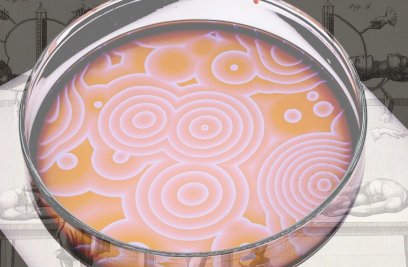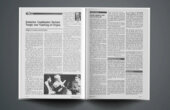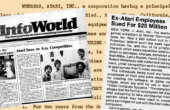Victor Frankenstein’s Technoscientific Dream of Reason
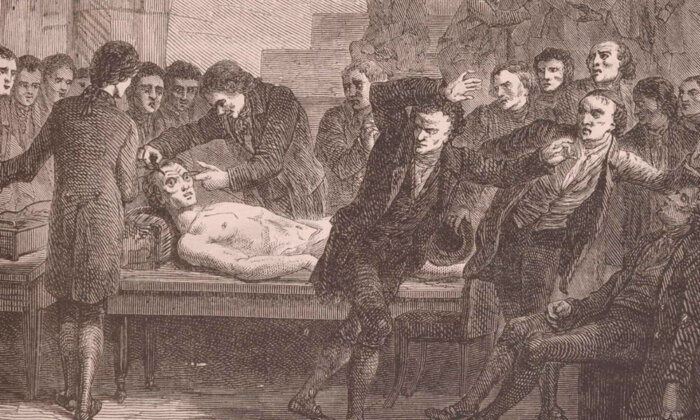
“Learn from me … how dangerous is the acquirement of knowledge”
Victor Frankenstein’s warning is one reason why his story continues to fascinate and why books like the present volume are written. The terrible repercussions of the ambition to become like Prometheus and “animate the lifeless clay” hold a stark lesson for today. This lesson, however, is not quite what it is often made out to be.
Early on in the book, Victor — the “modern Prometheus” of Mary Shelley’s subtitle — lets on that his inclination is not so modern after all but is indebted to premodern, mystical authors such as the alchemists Cornelius Agrippa (Heinrich Cornelius Agrippa von Nettesheim, 1486–1535) and Albertus Magnus (c. 1200–1280):
I should certainly have thrown Agrippa aside, and, with my imagination warmed as it was, should probably have applied myself to the more rational theory of chemistry which has resulted from modern discoveries. It is even possible, that the train of my ideas would never have received the fatal impulse that led to my ruin. …
It may appear very strange, that a disciple of Albertus Magnus should arise in the 18th century; but our family was not scientifical, and I had not attended any of the lectures given at the schools of Geneva. My dreams were therefore undisturbed by reality; and I entered with the greatest diligence into the search of the philosopher’s stone and the elixir of life.
For Mary’s readers in 1818, Victor’s aspirations did not fit “in this enlightened and scientific age”; they were out of sync with rational theory and the modern discoveries of chemistry.
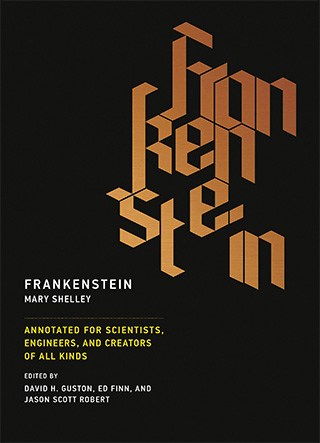
So the creature is not a product of modern science, and yet we fancy Victor as a mad scientist in a laboratory filled with fumes and sparks from modern apparatus. How is it that this premodern mystical alchemist appears so contemporary today?
The answer is as easy as it is provocative: perhaps today’s “Frankenfoods” and “Frankenmaterials” are not the products of modern science, either, but a return to alchemical dreams of reason. Undisturbed by reality, they are “animated by an almost supernatural enthusiasm.”
Indeed, Mary’s novel suggests not only that magic and alchemy preceded science but also that science can infuse and revive their prescientific ambitions. Victor’s teacher M. Waldman points him in this direction when he portrays modern science as a rite of passage that will allow Victor to reclaim the alchemist’s desire to “bestow animation upon lifeless matter.” In and of itself, the world of science is a disenchanted world with causal knowledge about the arrangements of facts. But before and beyond the enlightened and scientific age lies a rather more magical world, enchanted and animated by almost unlimited powers:
“The ancient teachers of this science,” said he, “promised impossibilities, and performed nothing. The modern masters promise very little; they know that metals cannot be transmuted, and that the elixir of life is a chimera. But these philosophers, whose hands seem only made to dabble in dirt, and their eyes to pore over the microscope or crucible, have indeed performed miracles. They penetrate into the recesses of nature, and shew how she works in her hiding places. They ascend into the heavens; they have discovered how the blood circulates, and the nature of the air we breathe. They have acquired new and almost unlimited powers; they can command the thunders of heaven, mimic the earthquake, and even mock the invisible world with its own shadows.
This description is an apt one, not only of those attempts that are most readily identified with Victor’s ambitions — to genetically engineer plants and animals, to technologically enhance human nature, to create artificial life, and to “banish disease from the human frame, and render man invulnerable to any but a violent death” — but also of the far more mundane achievements of today’s synthetic chemistry, nanotechnology, and materials science, with ordinary plastics first in line to mock the world with its own shadows. In 1957, Roland Barthes discussed plastics not as an application of polymer science but as “the magical operation par excellence: the transmutation of matter”:
This is because the quick-change artistry of plastic is absolute: it can become buckets as well as jewels. Hence a perpetual amazement. … And this amazement is a pleasurable one, since the scope of the transformations gives man the measure of his power. … [T]he age-old function of nature is modified: it is no longer the Idea, the pure Substance to be regained or imitated: an artificial Matter, more bountiful than all the natural deposits, is about to replace her, and to determine the very invention of forms.
Before and beyond the enlightened and scientific age lies a rather more magical world, enchanted and animated by almost unlimited powers.
Plastic signifies the malleability — indeed, the plasticity — of the material world. With sufficient ingenuity, anything can become anything else; the wealth of natural forms is mocked by the unbounded inventiveness of designers; and, in the words of nanotechnologist Gerd Binnig, we are witnesses and shapers of a second creation: “We have to become familiar with the idea that there is nothing inferior about dead matter. All the wonders of the world are contained, for example, in a stone, as all the laws of nature (and thus all the possibilities that can emerge from them) are reflected in it.” If plastic, according to Barthes, “is in essence the stuff of alchemy,” so are ongoing attempts to transform dead matter into smart materials, to declare that dirt-repellant coatings make for self-cleaning surfaces, and to teach refrigerators to report back to us about milk going bad and eggs running low. These attempts to animate things, to give them intelligence, or to make them come to life are undisturbed by reality in that they do not accept things as they are in virtue of their first or original creation. They instead make things subject to a second creation, presumably of our own making.
Mary’s tale is not one of modern science. On the contrary, it tells the limits of science and dreams the dream of technoscience, a dream that gains power in the plastic world of Frankenmaterials.
Science is the theoretical knowledge produced by those who seek to describe or represent the world and are aided in this quest by technology. The person who pursues this science is Homo depictor, the Representer; technoscience is technological knowledge produced by those who seek to control how things work together and are aided by theory in this effort; the person who pursues technoscience is Homo faber, the Maker.
Science seeks to understand the world to the extent and in the ways that humans can comprehend it. Because the human mind is limited, science is essentially modest — the transmutation of matter and the making of gold from base metals are not on its agenda.
Scientists are not interested in creating the philosopher’s stone to transform lead into gold or the elixir of life. “It was very different,” says a crestfallen Victor, “when the masters of the science sought immortality and power; such views, although futile, were grand: but now the scene was changed. The ambition of the inquirer seemed to limit itself to the annihilation of those visions on which my interest in science was chiefly founded. I was required to exchange chimeras of boundless grandeur for realities of little worth.” By definition, perhaps, what the mind can comprehend is well proportioned, measured, and not apt to provoke awe. When we make a model, for example, and liken the inside of an atom to a miniaturized solar system with planets orbiting its core, we effectively create a mental image that cuts things down to size so that we can easily comprehend them. We do so even as we acknowledge that, really, electrons are not like solid bodies at all but something that eludes our commonsense conceptions. If science formerly relied on simplification in order to reduce complexity, to picture and explain things, this reliance did not stifle the ambition to be creative and generate complexity even where it surpasses our intellectual powers.
The history of technology testifies to this ambition, and the technology of the computer allows us to exceed the limits of our science. The statements that represent slices of reality — each of little worth — can be built into a complex system of statements simulating a dynamic process that may also be observed in nature or that is entirely artificial. Either way, with statements that reduce complexity and simplify things for the purpose of human understanding, one can now generate a system that quickly becomes too complex for the human mind: too many lines of code, too many parameters to keep track of.
On the basis of science but far beyond its limits, we have “acquired new and almost unlimited powers … can command the thunders of heaven, mimic the earthquake, and even mock the invisible world with its own shadows.” We have made a machine that serves to model and predict the behavior of complex systems and, in effect, does the work of thinking for us. Quite independently of whether we have solved the problem of “artificial intelligence” and as unspectacular as the invention of plastic, this achievement is yet another example of bestowing animation upon lifeless matter. It is also another example of being undisturbed by reality — that is, by the limitations of the human mind: “Whence, I often asked myself, did the principle of life proceed? It was a bold question, and one which has ever been considered as a mystery; yet with how many things are we upon the brink of becoming acquainted, if cowardice or carelessness did not restrain our inquiries.”
Unrestrained by cowardice and carelessness, Victor pursues his inquiries obsessively: “It was a most beautiful season; never did the fields bestow a more plentiful harvest, or the vines yield a more luxuriant vintage: but my eyes were insensible to the charms of nature.” In more ways than one, to the obsessive gaze the world takes on a dual aspect: “To examine the causes of life, we must first have recourse to death. I became acquainted with the science of anatomy: but this was not sufficient; I must also observe the natural decay and corruption of the human body.” Nothing is what it seems: The lively charms of nature harbor decay and corruption; what is naturally given is a promise or sign of what can be technologically; and lifeless matter is imbued by a mind, whereas our brain for climate change is a mere machine.
When things take on such a dual aspect, when they are not what they appear to be but endowed with secret powers, they become uncanny. This is the starting point for Sigmund Freud’s famous analysis of the uncanny. Quoting Erich Rentsch, Freud notes that, “in telling a story, one of the most successful devices for easily creating uncanny effects is to leave the reader in uncertainty whether a particular figure in the story is a human being or an automaton” — or, one might add, whether that figure is lifeless matter from the graveyard or a living being. Today, it is not just the robots and zombies in the movies but also the devices that surround us that, as Freud explains, instill “doubts whether an apparently animate being is really alive; or conversely, whether a lifeless object might not be in fact animate.”
Consider, for example, the ambition to create ambient intelligence in smart environments. As we move through the world, a network of sensors would collect background information about the quality of air; it would attach Wikipedia entries to the streets and houses we pass; it would signal the presence of friends, charging stations, and goods. This world would be a magical one in which all things are endowed with meaning, subject to our wishes, which may be granted if we conjure the powers properly — not by praying but by speaking to them or choosing the right app. With ambient intelligence and ubiquitous computing, the natural environment takes on a dual aspect, and aided by modern science and technology we advance to a premodern animistic world.
Contemporary technoscience is undisturbed by reality in that it flaunts its inventions that surpass the limited vocabulary of forms and shapes in nature; it is undisturbed by reality in that it draws on scientific understanding to generate a degree of complexity that exceeds the natural intellectual power of human minds; and it is undisturbed by reality in that it creates monsters — lifeless things that appear to be animated by a mind or a soul as well as lively, talkative, and animated things that are merely machines. And as we are learning to live and interact with such monsters, there is nothing particularly terrible or frightening about them, although they are sometimes a bit unsettling, uncanny, leaving us unsure just what and who we are dealing with when we eat genetically modified foods, when we talk to our cell phones, when we watch a computer generate on screen the right path for a hurricane, when we try to imagine that we wade all the time through a sea of information-laden radio waves or are surrounded by electrical wiring in every room of every house.
“With an anxiety that almost amounted to agony, I collected the instruments of life around me, that I might infuse a spark of being into the lifeless thing that lay at my feet.”
The dreams of materials science, of information and communication technology, of biomedical research, of synthetic biology seek to overcome or transgress the limits of the given world with an almost supernatural enthusiasm. In the midst of this story, it might be worthwhile to pause and reflect—only to discover, as Victor did, “that I am moralizing in the most interesting part of my tale”:
A human being in perfection ought always to preserve a calm and peaceful mind, and never to allow passion or a transitory desire to disturb his tranquillity. I do not think that the pursuit of knowledge is an exception to this rule. If the study to which you apply yourself has a tendency to weaken your affections, and to destroy your taste for those simple pleasures in which no alloy can possibly mix, then that study is certainly unlawful, that is to say, not befitting the human mind.
In an age of technoscience, it has become quite difficult even to understand this injunction. Are we supposed to achieve perfection merely by taking pleasure in unadulterated things that are unspoiled by excessive ambition? The dispassionate scientist describes things peacefully as they are, no matter what good or ill they signify. But there is no such tranquility when Victor or one of our contemporary technoscientists seeks to perfect his or her powers on “a dreary night of November”: “With an anxiety that almost amounted to agony, I collected the instruments of life around me, that I might infuse a spark of being into the lifeless thing that lay at my feet.”
Alfred Nordmann is Professor of Philosophy at Technische Universität Darmstadt and Adjunct Professor of Philosophy at the University of South Carolina. This article is excerpted from the volume “Frankenstein: Annotated for Scientists, Engineers, and Creators of All Kinds.” An open access edition of the book can be freely downloaded here.
